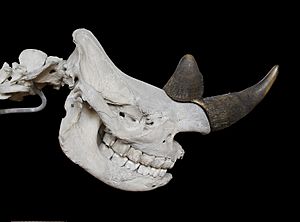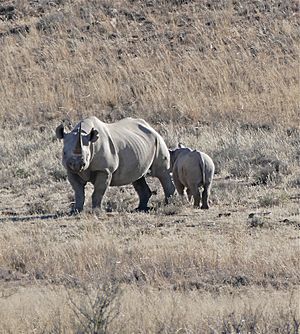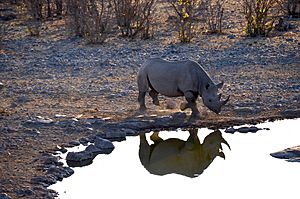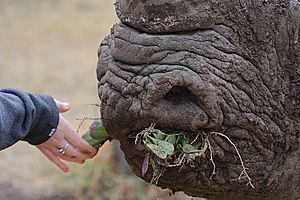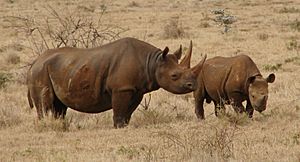Black rhinoceros facts for kids
Quick facts for kids Black rhinoceros orhook-lipped rhinoceros |
|
|---|---|
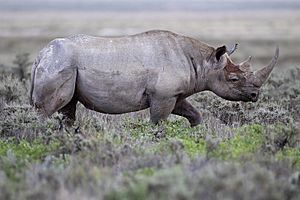 |
|
| A south-western black rhinoceros (D. b. occidentalis) in Etosha National Park, Namibia | |
| Conservation status | |
| Scientific classification | |
| Genus: |
Diceros
|
| Species: |
bicornis
|
| Subspecies | |
|
Diceros bicornis bicornis † |
|
 |
|
| Historical black rhinoceros range (ca. 1700 A.D.). Hatched: Possible historical range in West Africa. | |
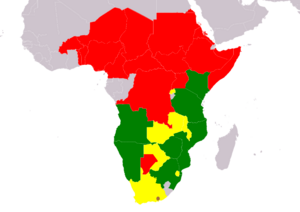 |
|
| Current black rhinoceros range Extant, resident Extinct Extant & Reintroduced (resident) Extant & Assisted Colonisation (resident) |
|
| Synonyms | |
|
|
The black rhinoceros, black rhino or hook-lipped rhinoceros (Diceros bicornis) is a species of rhinoceros, native to eastern and southern Africa including Angola, Botswana, Kenya, Malawi, Mozambique, Namibia, South Africa, Eswatini, Tanzania, Zambia, and Zimbabwe. It is the only extant species of the genus Diceros.
Contents
Description
An adult black rhinoceros stands 140–180 cm (55–71 in) high at the shoulder and is 3–3.75 m (9.8–12.3 ft) in length. An adult typically weighs from 800 to 1,400 kg (1,760 to 3,090 lb), however unusually large male specimens have been reported at up to 2,896 kg (6,385 lb). The cows are smaller than the bulls. Two horns on the skull are made of keratin with the larger front horn typically 50 cm (20 in) long, exceptionally up to 140 cm (55 in). Sometimes a third, smaller horn may develop. These horns are used for defense, intimidation, and digging up roots and breaking branches during feeding.
The black rhino is smaller than the white rhino and close in size to the Javan rhino of Indonesia. It has a pointed upper lip, which it uses to grasp leaves and twigs when feeding, whereas the white rhinoceros has square lips used for eating grass. The black rhinoceros can also be distinguished from the white rhinoceros by its size, smaller skull, and ears; and by the position of the head, which is held higher than the white rhinoceros, since the black rhinoceros is a browser and not a grazer.
Their thick-layered skin helps to protect black rhinos from thorns and sharp grasses. Their skin harbors external parasites, such as mites and ticks, which may be eaten by oxpeckers and egrets. Such behaviour was originally thought to be an example of mutualism, but recent evidence suggests that oxpeckers may be parasites instead, feeding on rhino blood. Their ears have a relatively wide rotational range to detect sounds. An excellent sense of smell alerts rhinos to the presence of predators.
Distribution
The natural range of the black rhino included most of southern and eastern Africa, but it did not occur in the Congo Basin, the tropical rainforest areas along the Bight of Benin, the Ethiopian Highlands, and the Horn of Africa.
Today it is totally restricted to protected nature reserves and has vanished from many countries in which it once thrived, especially in the west and north of its former range. The remaining populations are highly scattered. Some specimens have been relocated from their habitat to better protected locations, sometimes across national frontiers. The black rhino has been successfully reintroduced to Malawi since 1993, where it became extinct in 1990. Similarly it was reintroduced to Zambia (North Luangwa National Park) in 2008, where it had become extinct in 1998, and to Botswana (extinct in 1992, reintroduced in 2003).
In May 2017, 18 eastern black rhinos were translocated from South Africa to the Akagera National Park in Rwanda. The park had around 50 rhinos in the 1970s but the numbers dwindled to zero by 2007. In September 2017, the birth of a calf raised the population to 19. The park has dedicated rhino monitoring teams to protect the animals from poaching.
In October 2017, The governments of Chad and South Africa reached an agreement to transfer six black rhinos from South Africa to Zakouma National Park in Chad. Once established, this will be the northernmost population of the species. The species was wiped out from Chad in the 1970s and is under severe pressure from poaching in South Africa. The agreement calls for South African experts to assess the habitat, local management capabilities, security and the infrastructure before the transfer can take place.
Behavior
Black rhinos are generally thought to be solitary, with the only strong bond between a mother and her calf. They are not very territorial and often intersect other rhino territories.
Males sleep longer on average than females by nearly double the time. Other factors that play a role in their sleeping patterns is the location of where they decide to sleep.
Black rhinos have a reputation for being extremely aggressive, and charge readily at perceived threats. They have even been observed to charge tree trunks and termite mounds. Black rhinos will fight each other, and they have the highest rates of mortal combat recorded for any mammal: about 50% of males and 30% of females die from combat-related injuries.
Black rhinos follow the same trails that elephants use to get from foraging areas to water holes. They also use smaller trails when they are browsing. They are very fast and can get up to speeds of 55 kilometres per hour (34 mph) running on their toes.
Diet
Black rhinos are herbivorous browsers that eat leafy plants, branches, shoots, thorny wood bushes, and fruit. The optimum habitat seems to be one consisting of thick scrub and bushland, often with some woodland, which supports the highest densities.
It has been known to eat up to 220 species of plants. There are 18 species of woody plants known to the diet of the black rhinoceros, and 11 species that could possibly be a part of their diet too. Black rhinos also have a tendency to choose food based on quality over quantity, where researchers find more populations in areas where the food has better quality.
Black rhinos live in several habitats including bushlands, Riverine woodland, marshes, and their least favorable, grasslands. They browse for food in the morning and evening. They are selective browsers but, studies done in Kenya show that they do add the selection material with availability in order to satisfy their nutritional requirements.
In the hottest part of the day they are most inactive- resting, sleeping, and wallowing in mud. Wallowing helps cool down body temperature during the day and protects against parasites. When black rhinos browse they use their lips to strip the branches of their leaves. Competition with elephants is causing the black rhinoceros to shift its diet. The black rhinoceros alters its selectivity with the absence of the elephant.
Communication
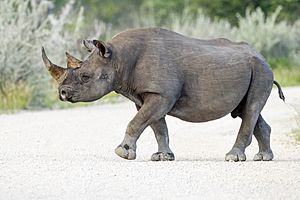
Black rhinos use several forms of communication. Due to their solitary nature, scent marking is often used to identify themselves to other black rhinos. The urine and feces of one black rhinoceros helps other black rhinoceroses to determine its age, sex, and identity. Less commonly they will rub their heads or horns against tree trunks to scent-mark.
The black rhino has powerful tube-shaped ears that can freely rotate in all directions. This highly developed sense of hearing allows black rhinos to detect sound over vast distances.
Reproduction
The adults are solitary in nature, coming together only for mating. Mating does not have a seasonal pattern but births tend to be towards the end of the rainy season in more arid environments.
Courtship behaviors before mating include snorting and sparring with the horns among males. Another courtship behavior is called bluff and bluster, where the black rhino will snort and swing its head from side to side aggressively before running away repeatedly. Breeding pairs stay together for 2–3 days and sometimes even weeks.
The gestation period for a black rhino is 15 months. The single calf weighs about 35–50 kilograms (80–110 lb) at birth, and can follow its mother around after just three days. Weaning occurs at around 2 years of age for the offspring. The mother and calf stay together for 2–3 years until the next calf is born; female calves may stay longer, forming small groups. The young are occasionally taken by hyenas and lions. Sexual maturity is reached from 5 to 7 years old for females, and 7 to 8 years for males. The life expectancy in natural conditions (without poaching pressure) is from 35 to 50 years.
Conservation
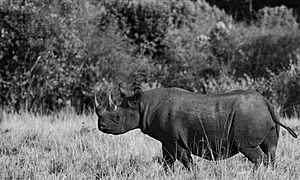
For most of the 20th century the continental black rhino was the most numerous of all rhino species. Around 1900 there were probably several hundred thousand living in Africa. During the latter half of the 20th century their numbers were severely reduced from an estimated 70,000 in the late 1960s to only 10,000 to 15,000 in 1981. In the early 1990s the number dipped below 2,500, and in 2004 it was reported that only 2,410 black rhinos remained. According to the International Rhino Foundation—housed in Yulee, Florida at White Oak Conservation, which breeds black rhinos—the total African population had recovered to 4,240 by 2008 (which suggests that the 2004 number was low). By 2009 the population of 5,500 was either steady or slowly increasing.
In 1992, nine black rhinos were brought from Chete National Park, Zimbabwe to Australia via Cocos Island. After the natural deaths of the males in the group, four males were brought in from United States and have since adapted well to captivity and new climate. Calves and some subadults are preyed on by lions, but predation is rarely taken into account in managing the black rhinoceros. This is a major flaw because predation should be considered when attributing cause to the poor performance of the black rhinoceros population. In 2002 only ten western black rhinos remained in Cameroon, and in 2006 intensive surveys across its putative range failed to locate any, leading to fears that this subspecies had become extinct. In 2011 the IUCN declared the western black rhino extinct. There was a conservation effort in which black rhinos were translocated, but their population did not improve, as they did not like to be in an unfamiliar habitat.
The only rhino subspecies that has recovered somewhat from the brink of extinction is the southern white rhinoceros, whose numbers now are estimated around 14,500, up from fewer than 50 in the first decade of the 20th century. But there seems to be hope for the black rhinoceros in recovering their gametes from dead rhinos in captivity. This shows promising results for producing black rhinoceros embryos.
In 2022 South Africa granted permits to hunt 10 black rhinos, stating that the population is growing.
Threats
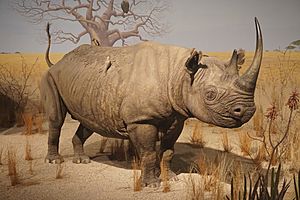
Today, there are various threats posed to black rhinos including habitat changes, illegal poaching, and competing species. Civil disturbances, such as war, have made mentionably negative effects on the black rhinoceros populations in since the 1960s in countries including, but not limited to, Chad, Cameroon, Rwanda, Mozambique, and Somalia.
Black rhinos face problems associated with the minerals they ingest. These rhinoceroses can overload on iron, which leads to build up in the lungs, liver, spleen and small intestine.
Illegal poaching for the international rhino horn trade is the main and most detrimental threat. The killing of these animals is not unique to modern-day society. A major market for rhino horn has historically been in the Middle East nations to make ornately carved handles for ceremonial daggers called jambiyas. The horn is also used in traditional Chinese medicine. It is also hunted for the Chinese superstitious belief that the horns allow direct access to Heaven due to their unique location and hollow nature.
Interesting facts about the black rhinoceros
- The species was first named Rhinoceros bicornis by Carl Linnaeus in the 10th edition of his Systema naturae in 1758.
- The name Rhinoceros bicornis was used to refer to the African rhinos until 1911.
- There seven or eight subspecies, of which three became extinct in historical times and one is on the brink of extinction.
- The rhinoceros originated in the Eocene about fifty million years ago.
- Although the species is referred to as black, its colours vary from brown to grey.
- The IUCN estimates that there are 3,142 mature individuals remaining in the wild.
- The longest known black rhinoceros horn measured nearly 1.5 m (4.9 ft) in length.
- It is commonly assumed that black rhinos have poor eyesight. However, studies have shown that their eyesight is comparatively good, at about the level of a rabbit.
- Adult rhinos normally have no natural predators, thanks to their imposing size as well as their thick skin and deadly horns.
- In exceptional circumstances, adult black rhinos have fallen prey to crocodiles . Calves and, very seldom, small sub-adults may be preyed upon by lions as well.
- They can live up to 5 days without water during drought.
See also
 In Spanish: Rinoceronte negro para niños
In Spanish: Rinoceronte negro para niños



